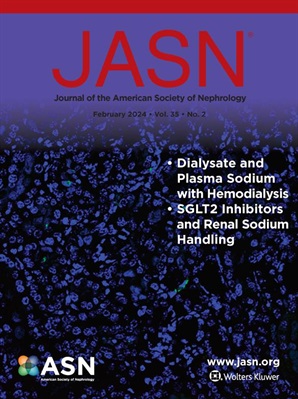解读不确定潜能的克隆造血:肾脏疾病的方法、机制和意义。
IF 10.3
1区 医学
Q1 UROLOGY & NEPHROLOGY
引用次数: 0
摘要
慢性肾脏疾病(CKD)折磨着超过10%的美国成年人,其患病率随着年龄的增长而急剧上升。不确定电位克隆造血(CHIP)是一种常见的、遗传异质性的血细胞疾病,其特征是由白血病体细胞突变驱动的与年龄相关的造血细胞克隆扩增,但没有血液恶性肿瘤或不典型增生。虽然CHIP是未来血液学恶性肿瘤的一个重要危险因素(估计为每年约0.5%,而无CHIP者为每年<0.1%),但在流行病学、细胞基础和小鼠研究中,它也与心血管疾病的两倍高有关。然而,最近的研究表明CHIP与慢性肾脏疾病和急性肾损伤等肾脏结局有关,独立于传统的危险因素。这篇综述涵盖了CHIP与肾脏疾病之间的观察结果和提出的假设。该综述还强调需要进一步研究阐明CHIP可能导致CKD及其合并症的不同途径,考虑到CKD分期和病因的异质性,以及CHIP是肾脏疾病的因果驱动因素还是衰老和合并症的标志。最后,我们讨论了抗炎治疗减轻CHIP对肾脏健康不良影响的潜力,旨在改善CHIP相关肾脏疾病患者的管理策略。本文章由计算机程序翻译,如有差异,请以英文原文为准。
Deciphering Clonal Hematopoiesis of Indeterminate Potential: Methods, Mechanisms, and Implications for Kidney Diseases.
Chronic kidney disease (CKD) afflicts over 10% of US adults, with its prevalence increasing sharply with age. Clonal hematopoiesis of indeterminate potential (CHIP) is a common, genetically heterogeneous blood cell disorder characterized by the age-related clonal expansion of hematopoietic cells driven by leukemogenic somatic mutations yet without hematologic malignancy or dysplasia. While CHIP is a strong risk factor for future hematologic malignancy (estimated at ∼0.5% per year, compared to <0.1% for those without CHIP), it is also linked to twofold higher cardiovascular disease in epidemiologic, cell-based, and murine studies. However, more recent work has implicated CHIP with renal outcomes such as chronic kidney disease as well as acute kidney injury, independent of traditional risk factors. This review covers the observations and proposed hypotheses linking CHIP and kidney disease. The review also underscores the need for further research to elucidate the distinct pathways through which CHIP may contribute to CKD and its comorbidities, considering the heterogeneity within CKD stages and etiologies, as well as whether CHIP is a causal driver of kidney disease or a marker of aging and comorbidity. Finally, we discuss the potential of anti-inflammatory treatments to mitigate CHIP's adverse effects on kidney health, aiming to improve management strategies for patients with CHIP-associated kidney diseases.
求助全文
通过发布文献求助,成功后即可免费获取论文全文。
去求助
来源期刊
CiteScore
22.40
自引率
2.90%
发文量
492
审稿时长
3-8 weeks
期刊介绍:
The Journal of the American Society of Nephrology (JASN) stands as the preeminent kidney journal globally, offering an exceptional synthesis of cutting-edge basic research, clinical epidemiology, meta-analysis, and relevant editorial content. Representing a comprehensive resource, JASN encompasses clinical research, editorials distilling key findings, perspectives, and timely reviews.
Editorials are skillfully crafted to elucidate the essential insights of the parent article, while JASN actively encourages the submission of Letters to the Editor discussing recently published articles. The reviews featured in JASN are consistently erudite and comprehensive, providing thorough coverage of respective fields. Since its inception in July 1990, JASN has been a monthly publication.
JASN publishes original research reports and editorial content across a spectrum of basic and clinical science relevant to the broad discipline of nephrology. Topics covered include renal cell biology, developmental biology of the kidney, genetics of kidney disease, cell and transport physiology, hemodynamics and vascular regulation, mechanisms of blood pressure regulation, renal immunology, kidney pathology, pathophysiology of kidney diseases, nephrolithiasis, clinical nephrology (including dialysis and transplantation), and hypertension. Furthermore, articles addressing healthcare policy and care delivery issues relevant to nephrology are warmly welcomed.

 求助内容:
求助内容: 应助结果提醒方式:
应助结果提醒方式:


